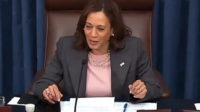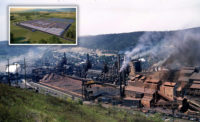The Biden administration has issued the first detailed guidance spelling out the labor-related steps that companies must take to qualify for billions of dollars in enhanced tax breaks and subsidies for clean energy and related projects that are in climate provisions of the recently enacted Inflation Reduction Act.
The key labor requirements detailed in the guidance, which the U.S. Treasury Dept.'s Internal Revenue Service released on Nov. 29, include hiring a certain proportion of construction apprentices who participate in registered programs and paying workers at prevailing wage rates in areas where projects are located, as required on federal and federal supported construction projects under the Davis Bacon Act.
In a briefing for reporters, Treasury Secretary Janet Yellen said that tax incentives account for $270 billion of the law’s $369 billion in climate-related investments.
She said that an underlying principle of the law, enacted on Aug. 16, is that “workers should benefit from the clean energy economy they’re helping build."
Companies that adopt the climate act's prevailing wage and apprenticeship provisions will see a "a 5x premium" over the base credit for such applications as clean power production and clean hydrogen, said John Podesta, senior White House adviser for clean energy innovation and implementation.
As an example, meeting the workforce standards can increase the investment tax credit for offshore wind energy projects from 6% to 30%, according to the law.
60-Day 'Clock'
The prevailing wage and apprenticeship requirements apply to eight tax incentives in the climate law, including the advanced energy project credit, carbon oxide sequestration, clean hydrogen, energy-efficient commercial buildings deduction, renewable energy production tax credit and renewable energy property investment tax credit.
Prevailing wage requirements—but not those for apprenticeship—apply to the new energy-efficient home credit and zero-emission nuclear power production credit.
Under the law, prevailing wage and apprenticeship requirements apply to facilities and projects on which construction begins 60 days or more after Treasury publishes the guidance in the Federal Register on Nov. 30.
That 60-day “clock” is expected to begin on Nov. 30. Thus the requirements will apply to facilities and projects on which construction begins on or after Jan. 29, 2023.
Related to apprenticeship provisions, the guidance says that for projects whose construction begins before Jan. 1, 2023, at least 10% of the work must be performed by apprentices who take part in programs registered with the U.S. Dept. of Labor or state agencies. That mandatory share of work rises in steps, to 15% for projects starting after Dec. 31, 2023.
The guidance also outlines how a "good faith effort exception" may apply in meeting the number of qualified apprentices from registered programs and outlines recordkeeping requirements related to prevailing wage payments and apprenticeship.
The Labor Dept. issued two Frequently Asked Question (FAQ) documents specific to the climate law, on prevailing wages and on apprenticeships.
Specifics Still Needed, Says Industry
In a statement, Sean McGarvey, president of North America's Building Trades Union, said it "welcomes this initial guidance" and will "look forward to further engagement and implementation on these critical issues as the process advances."
Industry groups said the guidance lacked detail that developers and contractors need to understand new requirements and penalties and weigh impacts on project costs and benefits.
"We are just going through it now," said Brian Turmail, Associated General Contractors of America vice president, shortly after documents were released. "But on first impression the guidance feels woefully short on details and specifics."
Turmail added: "It is hard to see how 20 pages of guidance will address the many questions about compliance and enforcement about an entirely new program being operated by an agency with no prior experience with these areas. The guidance is vague about whether the new requirements will apply to offsite work, an issue we strongly oppose. Unfortunately, this document appears to leave room for multiple interpretations."
The Solar Energy Industries Association, in early November comments to IRS totalling 38 pages, asked the agency for draft guidance on prevailing wage payments and apprentice programs "with a reasonable time period for public comment prior to issuing final guidance that triggers the IRA 60-day clock."
The group noted need for clarity in areas such as wage classifications and interstate use of apprentices—as well as in non-labor provisions pertaining to domestic content of materials and boundaries of former fossil fuel dominated "energy communities" in siting new projects to gain maximum tax credit.
Meeting apprentice numbers in still developing U.S. offshore wind construction may be impossible, National Ocean Industries Association President Eric Milito stressed In a letter to Congress, according to a report in industry publication Recharge. “Marine construction, operations, and maintenance is a specialized area with already steep licensing requirements,” he said. “It is unclear if the industry would be able to secure apprentices with the right qualifications and safety training.” The group said it would offer added comment in further review of the guidance.
Ben Brubeck, vice president of the Associated Builders and Contractors, which also submitted earlier comments, added that “IRS says it will issue additional proposed regulations with respect to these requirements in the coming months and there are more questions that need to be answered between now and when this rule goes into effect in roughly 60 days."
He noted that developers, small and large contractors and other project stakeholders "need clear and specific guidance on how these new provisions will be implemented ... to decide whether the tax credits are worth the significant risks and penalties ,,, and whether to bid on and perform such work.”
JC Sandberg, interim CEO of the American Clean Power Association, said “further clarity is essential to provide the market certainty necessary to drive timely clean energy deployment and to support job creation at levels that will ensure the IRA lives up to its promise.”







Post a comment to this article
Report Abusive Comment